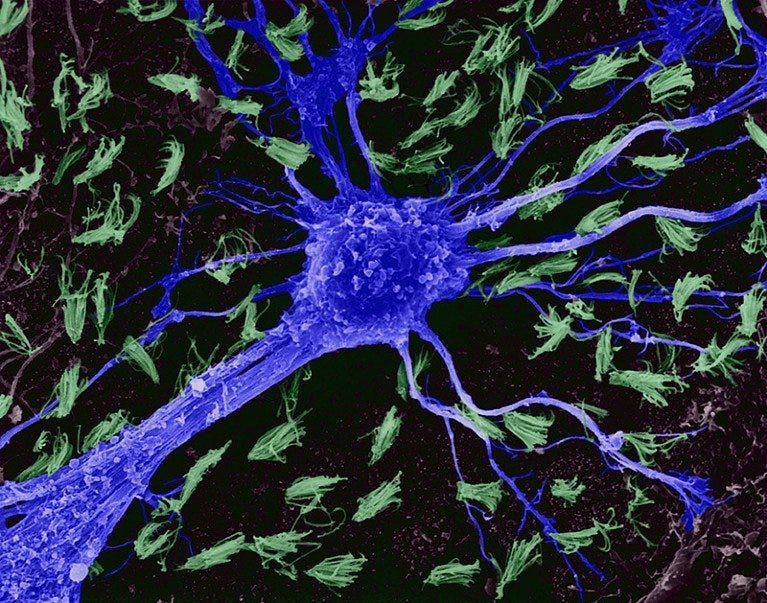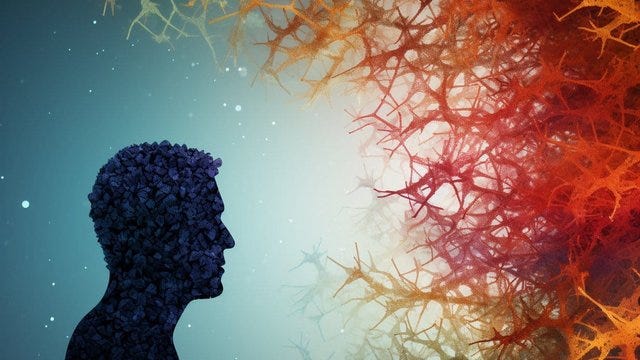Sci-Ed Update 297
Brain map, why antidepressants take time, post-COVID issues, microbiome transplant & Alzheimer symptoms, caffeine helps thyroid, 170 genes for color variations, human variety in A&P, diet hypothesis
This is the largest map of the human brain ever made

Researchers have created the largest atlas of human brain cells so far, revealing more than 3,000 cell types — many of which are new to science. The work, published in a package of 21 papers today in Science, Science Advances and Science Translational Medicine, will aid the study of diseases, cognition and what makes us human, among other things, say the authors.
The enormous cell atlas offers a detailed snapshot of the most complex known organ. “It’s highly significant,” says Anthony Hannan, a neuroscientist at the Florey Institute of Neuroscience and Mental Health in Melbourne, Australia. Researchers have previously mapped the human brain using techniques such as magnetic resonance imaging, but this is the first atlas of the whole human brain at the single-cell level, showing its intricate molecular interactions, adds Hannan. “These types of atlases really are laying the groundwork for a much better understanding of the human brain.”
The research is part of the US National Institutes of Health’s Brain Research through Advancing Innovative Neurotechnologies Initiative — Cell Census Network (BICCN), a collaboration between hundreds of scientists. The programme’s goals include cataloguing brain cell types across humans, non-human primates and mice to improve understanding of the cellular mechanisms behind poorly understood brain disorders. The data from the 21 studies have been made publicly available on the Neuroscience Multi-omic Archive online repository.
Read more→ AandP.info/359
Breakthrough on How Antidepressants Work – Why They Take Weeks To Kick-In
SSRI antidepressants normally take a few weeks before any showing mental health benefits, but how come it takes so long? Now a study from a group of clinicians and scientists provides the first human evidence that this is due to physical changes in the brain leading to greater brain plasticity developing over the first few weeks of SSRI intake. This may also begin to explain one of the mechanisms of how antidepressants work.
This work was presented at the ECNP conference in Barcelona on October 9th. This work is also due to be published (has been accepted) in a peer-reviewed journal.
Read more→ AandP.info/9jm
Research: Autoimmune, Autoinflammatory Disorders Rise After COVID
After being infected with COVID-19, people have a much higher risk of getting autoimmune and autoinflammatory connective-tissue disorders like alopecia, Chron’s disease, psoriasis and vitiligo, according to new research.
Vaccination lowers the risk, says the study from South Korea, which was published in JAMA Network Open.
Researchers looked at information on more than 350,000 COVID-19 patients from between October 2020 and December 2021. They also used a control group of more than 6.1 million people. The average age in both groups was 52. They were split evenly among the sexes.
“Notably, certain disease risks exhibited a positive association with the severity of COVID-19,” the researchers wrote. "Possible associations of COVID-19 with autoimmune diseases… have been suggested, because SARS-CoV-2 appears to perturb self-tolerance and trigger autoimmune reactions via cross-reactivity that may lead to the development of autoimmune diseases.”
Read more→ AandP.info/h9k
Alzheimer’s Symptoms Transferred via Microbiota Transplant
A new study confirmed a link between gut microbiota and Alzheimer’s disease.
The research demonstrated that Alzheimer’s symptoms could be transferred to young, healthy organisms through gut microbiota transplants. Alzheimer’s patients exhibited a heightened presence of inflammation-causing bacteria, correlating with their cognitive state.
This discovery emphasizes the gut microbiome as a pivotal area of investigation for Alzheimer’s.
Key Facts:
Memory impairments in Alzheimer’s patients can be transferred to young animals via gut microbiota transplants.
Increased inflammation-promoting bacteria in the gut is directly connected to cognitive decline in Alzheimer’s patients.
The research suggests that early intervention by studying the role of gut microbes during the initial stages of dementia could lead to new therapeutic approaches.
Read more→ AandP.info/vjx
Can Caffeine Improve Thyroid Function?
Caffeine consumption may improve thyroid function for people with metabolic disorders, new research shows.
"Although the causal relationship between caffeine intake and thyroid function requires further verification, as an easily obtainable and widely consumed dietary ingredient, caffeine is a potential candidate for improving thyroid health in people with metabolic disorders," report the authors in the study, published in Nutritional Journal.
Caffeine intake, within established healthy ranges, showed a nonlinear association with thyroid levels.
Moderate caffeine intake has been associated with reducing the risk of metabolic disorders in addition to showing some mental health benefits. However, research on its effects on thyroid hormone, which importantly plays a key role in systemic metabolism and neurologic development, is lacking.
Read more→ AandP.info/ypc
Nearly 170 genes determine hair, skin and eye color, CRISPR study reveals
Human skin, hair, and eyes come in a huge variety of colors, but until now, scientists have only known a fraction of the genetic diversity driving this variation. Now, new research finds many dozens of genes that may produce this broad diversity.
In a genome-wide screening, researchers pinpointed 169 genes that are likely involved in human pigmentation, including 135 previously not known to play a role. Because of the wide distribution of pigments within the human body, some of these genes might be involved in disorders such as the skin cancer melanoma and even Parkinson's disease, which affects pigmented cells in a region of the brain important for movement, the study authors reported.
"Pigmentation by itself is interesting both in the context of human variation and evolution, but also in the context of disease," study leader Joanna Wysocka, a developmental biologist at Stanford University and the Howard Hughes Medical Institute, told Live Science.
Read more→ AandP.info/c4v
Anatomic Variations in Humans
Let’s chat about the rich tapestry of variations among humans. It’s a popular classic episode of The A&P Professor podcast for anatomy and physiology faculty from a few years ago.
To listen to this episode, click on the player button above ⏵ (if present) or this link→ theAPprofessor.org/podcast-episode-43.html
The fructose survival hypothesis as a mechanism for unifying the various obesity hypotheses
The pathogenesis of obesity remains contested. Although genetics is important, the rapid rise in obesity with Western culture and diet suggests an environmental component. Today, some of the major hypotheses for obesity include the energy balance hypothesis, the carbohydrate-insulin model, the protein-leverage hypothesis, and the seed oil hypothesis. Each hypothesis has its own support, creating controversy over their respective roles in driving obesity. Here we propose that all hypotheses are largely correct and can be unified by another dietary hypothesis, the fructose survival hypothesis. Fructose is unique in resetting ATP levels to a lower level in the cell as a consequence of suppressing mitochondrial function, while blocking the replacement of ATP from fat. The low intracellular ATP levels result in carbohydrate-dependent hunger, impaired satiety (leptin resistance), and metabolic effects that result in the increased intake of energy-dense fats. This hypothesis emphasizes the unique role of carbohydrates in stimulating intake while fat provides the main source of energy. Thus, obesity is a disorder of energy metabolism, in which there is low usable energy (ATP) in the setting of elevated total energy. This leads to metabolic effects independent of excess energy while the excess energy drives weight gain.
Kevin Patton comment→ The topics of diet, body mass, and obesity are fraught with misunderstandings and biases. Scientists have yet to work out the core concepts of these topics. Yet, they are pertinent to discussions within the A&P course. Here’s an article to keep us up to date on what’s happening in the evolution of related hypotheses.
Read more→ AandP.info/86k (see AandP.info/2lq for a summary)









